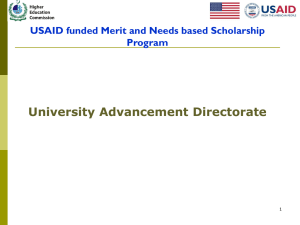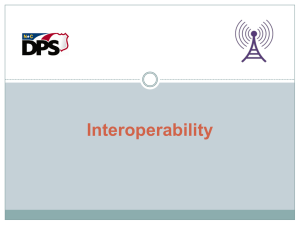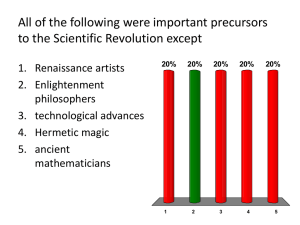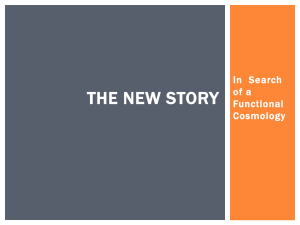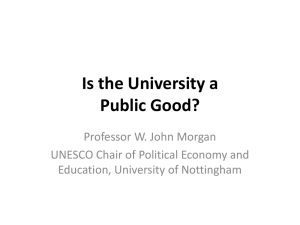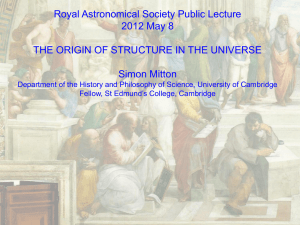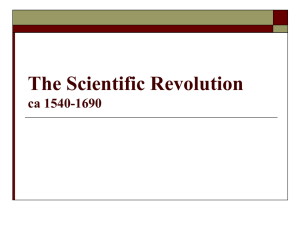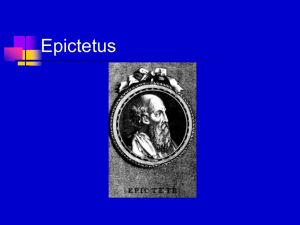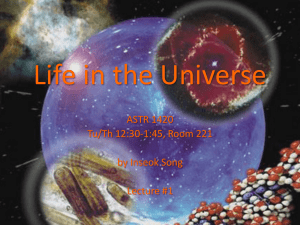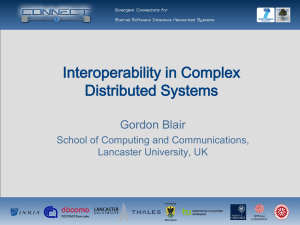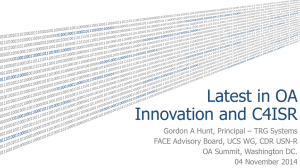Removing the barriers in front of information, a democratic approach
advertisement
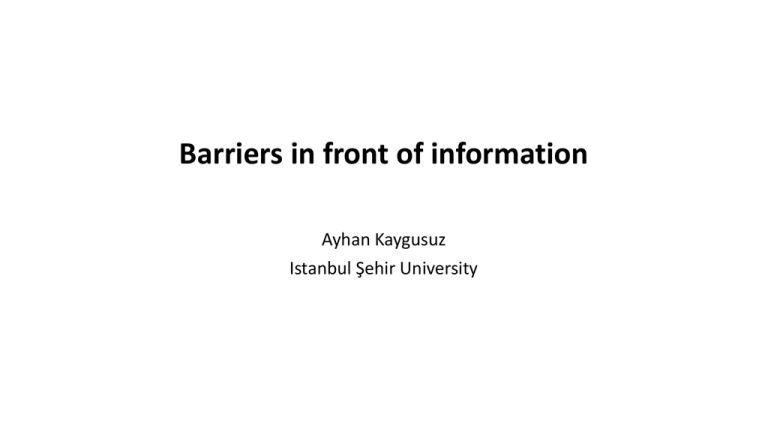
Barriers in front of information Ayhan Kaygusuz Istanbul Şehir University First examples of intellectual productions • First examples of intellectual productions go back to 20-30 thousand years ago. Human being started painting cave walls for communicating with others. At that time the media was cave walls and communication method was visual communication. • After then people found other ways for sharing, storing and preserving their knowledge and ideas. They used different tools and medias for that purpose. • There were a variety of information carriers from clay tablets to papyrus and parchments. Then paper has a long life for about 2.000 years up to now. • Paper and printing machine have played an important role in the history of humanity. Inventing printing press was one of the most important revolution in the history. The importance of this revolution is dissemination of information to a wider audience. • Between 15th and 20th centuries main media was books and periodicals. • Storage and preservation of information were primitive and easy comparing today. First examples of intellectual productions • The Venus of Willendorf - 24,000 BC • Man from Brno, Czech Republic - c.30,000 BC • Mammoth from Vogelherd Cave, Germany c.25,000 BC • Mother Goddess from Laussel, France - c.22,000 BC • Woman's Head from Brassempouy, France - c.22,000 BC • Clay Bison, Tuc d'Audoubert, Ariege - c.15,000 BC • Mother Goddess of Catal Huyuk - c.6000 BC • Man and Woman from Cernavoda Romania - c.4000 BC • Stone Henge, Salisbury England - c.2100 BC • Moai Statues, Easter Island, Chile - Disputed Time Range • Lascaux France Cave • Lascaux France Bull First examples of intellectual productions Production and recording information Production and recording information Production and recording information Production and recording information Production and recording information Circulation of information Circulation of information Liber Chronicarum (Nuremberg Chronicle) The Gentleman’s Magazine Storage and preservation of information 1990s • Widening access to information has contributed to the speed of science and developments. • After 1990s almost everything has changed. • 1990s are the beginning of a new era and internet has had a great impact on our daily lives. 1990s After Internet • Instant messaging, • Voice over Internet, • Two-way interactive video calls, • World Wide Web • Discussion forums, • Social networking, • Online shopping • And production and publishing scientific information are the most affected areas. Main differences between the old times and now • Amount of information is not comparable • The media, -information carriers- are different • Delivery method of information has completly changed, • Storage and preservation of information are much more complicated and expensive than the old times. Information Growth Information Growth • I agree with the definition that was made 19 years ago. ICT are primary reason for information overload. Speed of dissemination of information has caused snow ball effect on production of information. • Information technology may be a primary reason for information overload due to its ability to produce more information more quickly and to disseminate this information to a wider audience than ever before (Evaristo, Adams, & Curley, 1995). How much information? Release date: October 27, 2003. © 2003 Regents of the University of California It is a difficult task to estimate the amount of information production. There are several studies to estimate how much information is produced. A study carried out by University of California showed that 5 exabytes new information was produced in 2002 and %92 of it was stored on magnetic media. In that study it was estimated that new stored information increased about 30% a year between 1999 and 2002. Size of digital universe The Expanding Digital Universe : a Forecast of Worldwide Information Growth Through 2010, IDC White Paper, March 2007 According to the report published by IDC the amount of digital information created, captured, and replicated was 161 exabytes in 2006. Estimation for the year 2010 was around 1.000 exabytes in this study. Size of digital universe • In the latest version of the study estimation for the size of digital universe was around 3.000 (2837) exabytes by 2012 and it will reach 40.000 exabytes = 40 zettabytes in 2020. Size of digital universe Two-third of the total amount of information is produced by USA, Western Europe and China. Rest of the world produces only one-third. Very latest version of the report published in April and the estimation was revised from 40 ZB to 44 ZB for 2020. Scientific Information • Scientific information is also increasing very rapidly. • Only three major publishers have more than 22 million articles in their databases. • OA publishing is growing too. It is not at a desirable level yet but by the May 2014 only DOAJ has more than 1.6 million articles. Scientific information Scientific information Scientific information OA publishing Digital divide • Enormous information growth has made it much more complicated to access information. One has to have ICT infrastructure, money and necessary competencies and skills to access information. • Description of digital divide explains the gap between geographic areas and societies. Digital divide describes the gap between those who have already access to information and communication technology and the skills to make use of those technology and those who do not have the access or skills to use those same technologies within a geographic area, society or community. http://en.wikipedia.org/wiki/Digital_divide Barriers to access information There are several barriers in front of information varying by countries, regions, societies and genders. Some of them are; • Technical barriers, • Financial barriers, • Information literacy issues Internet usage statistics is one of the important indicator showing technical barriers. Only 15 percent of population has internet access in Africa, this rate is almost 80% in North America. This creates a big gap between the societies in terms of accessing digital information. Only 34 percent of the world’s population has internet access by June 2012. Barriers to access information • There is a big difference between least developed countries and developed world • Growth is higher in the developing world than the developed world but it seems it will take too long to catch up. • Following comparisions are from International Telecommunication Union showing inequalities between poor and rich. • 14 most expensive broadband out of 20 are in Africa. • In 9 poorest countries internet is 2 times expensive than the average monthly income. • 14 most affordable economies out of 20 are in Europe in terms of broadband costs. Broadband Commission Statshot - September 2012 Growth between developing and Developed World Between 2010-2011 Broadband Costs Processing and protecting information • There are other technical difficulties information professionals have been facing. These are processing and protecting the information. According to IDC’s study only 3% of the digital information is "tagged" and half a percent of the digital information is analyzed by 2012. • Estimation for the size of digital universe was 3.000 exabytes for 2012 and a third of that data requires protection. But only half of the data was protected that requires protection. Processing and protecting information The amount of information in the digital universe that is "tagged" accounts for only about 3% of the digital universe in 2012, and that which is analyzed is half a percent of the digital universe. IDC's Digital Universe Study Much of the digital universe is unprotected. IDC estimates that about a third of the data in the digital universe requires some type of protection. Interoperability • The other technical barrier is the lack of interoperability between systems. Tens of different systems are working in an organisation to achive the goals of the organization. But in general there are interoperability problems at all levels, institutional, national and international. Interoperability Interoperability refers to how well two or more systems work together to achieve a common goal. Interoperability is multilateral by nature and is best understood as a shared value of a community. European Investigation of Information Systems Interoperability in UK universities, Menzies, Birrell and Dunsire, 2011. Interoperability Framework (EIF) for European public services, Bruxelles, le 16.12.2010 COM(2010) 744 final European Interoperability Framework (EIF) Needs for Interoperability; Benefits of interoperability; • cooperation among public administrations with the aim to • improved public service establish public services; delivery to citizens and • exchanging information among businesses by facilitating the public administrations to fulfil one-stop-shop delivery of legal requirements or political public services; commitments; • lower costs for public • sharing and reusing information administrations, businesses and among public administrations to citizens due to the efficient increase administrative efficiency delivery of public services. and cut red tape for citizens and businesses. European Interoperability Framework (EIF) for European public services, Bruxelles, le 16.12.2010 COM(2010) 744 final Financial Barriers • Scientific information is very expensive. Latest survey showed that average price per title varies by discipline between 1401-4450 USD. According to the ARL statistics expenditures for serials has increased 400 percent between 1986-2011. Profit margins of major academic publishers are going up. • Price of information is increasing but library budgets are getting less every year. Library expenditures have come down from 3.7 percent to 1.8 percent. There is a 50 percent cut in last 32 years time. Financial Barriers Library Expenditure in Total University Expenditure ARL Statistics 2007-2008 2010-2011 Information literacy • Information literacy has become an important issue in the information age. • An internet search may retrieve over one billion hits on a subject like climate change. Without having necessary competencies and skills it is almost impossible to review the results. • Unfortunately information literacy is not a part of teaching systems in most of the schools. Literacy Issues Language Barriers The language is another barrier in terms of accessing information. 56 percent of the web content is in English. Languages which are spoken by large population are represented with a small percentage in web content. The following content languages are used by less than 0.1% of the websites Conclusions • As a result, ICT have had a great impact on production and distribution of information. But all individuals and societies do not have equal opportunities to access the information because of technical, financial and literacy barriers. • Growth and circulation of information are positive developments and we see the effects and contributions of these developments in our everyday lives. Unfortunately these positive developments will widen gap between societies and digital divide will be one of the most important issues of the world. National Academic Repository Project Figures about Turkish HEI • • • • • • • • 76 million people, % 43 under 25 years old 2 million students take exam to enter university 104 state and 72 foundation, 176 universities 99 of the universities established after 2006 5.4 million students in all levels of higher education 280.000 master’s and doctoral students 142.000 teaching and reserach staff in HEI Around 30.000 articles are published in citation indexes per year National Academic Repository Project • At the beginning of 2014 a project has been started by the HEC of Turkey. • The aim of the project is to establish instituonal repositories in all universities and a harvesting system will be created in the HEC. • In October 2014, in the open access week, the project will be evaluated and best practicies from other countries will be reviewed. National Academic Repository Project • Training materials have been prepared and published on the website of the HEC in February 2014. • A training program was organised for 327 librarians and IT staff of 176 universities on 3rd of March. • A frame Policy document has been created on IR&OA for the Higher Education Council and all universities have been asked to create their own policies in accordance with that frame policy in April 2014. • In addition to the provisions on instituonal repositories and open access HEC encourages the universities to create Research Data Management policies. • For sharing the experiences and easily exchanging and harvesting data Dspace has been recommended to universities. • Universities will install, register and test Dspace until end of May 2014. • Second seminar will be organised for the librarians and practical issues, such as creating accounts, data entry, copyrights issues will be disscussed in the seminar on 30th of May. • Libraries will create or convert their data into Dspace between June-October 2014. • The HEC will design a platform for harvesting all IR of the universities until October 2014. • Thesis and dissertations will be gradually converted into the new system in the HEC. • First results of the project will be evaluated in the “open access week” on 20-21 October 2014. • At the end of that project the HEC will take initiative to suggest a national OA Policy, including research data, to the related institution. e-Türkiye • Turkey has a portal called e-state and it is in service since December 2008. • From 44 public institutions 380 services are accessible through e-state portal by the May 2014. • Every Turkish citizens can access to the portal using their unique personal identification number. • By the May 2014 around 18 million citizens have been using the system. • All public institution have been carrying their services under that portal. These institutions have to use the guide that sets out standards and principles of interoperability. • e-Türkiye e-Türkiye The main goals of the project are; • To improve delivery of public services to Turkish citizens through a single platform. • Reduce the costs for public administrations and citizens by delivering efficient public services. e-Türkiye e-Türkiye Thank you for your attention ayhankaygusuz@sehir.edu.tr

